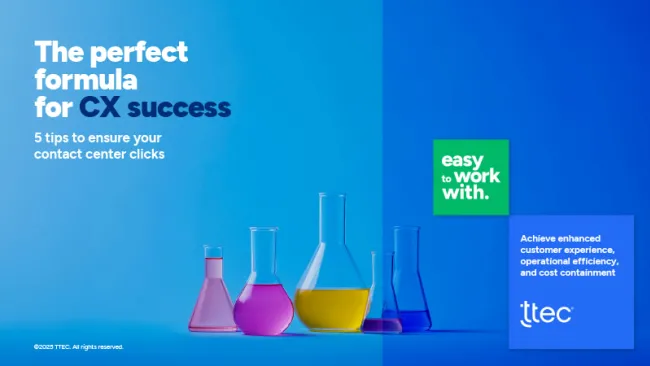We live in the age of customer experience, where anticipating the needs of customers is starting to become a mainstream strategy. Forward-thinking organizations, however, know that customer interaction expectations are evolving to more impactful, individualized, and seamless engagement from brands. Customers who receive a stellar experience from one company now expect that same level of experience everywhere.
Increased consumer expectations will require companies in the future to create an unrelenting focus on the customer throughout the enterprise. The leaders will continuously introduce new skills, align their workforces around customer metrics, create new products and services from real-time customer feedback, and be fearless of change and innovation on the horizon.
For the 2020 customer, superior customer experience and customer knowledge will be the competitive differentiator and the centerpiece to an enterprise's success. Looking ahead, we have identified four strategic imperatives for growing your business along with your customers:
1. Put yourself into your customers' shoes.
Companies that want to innovate shouldn't waste time analyzing market research reports. Instead, they need to put themselves in their customers' shoes. Understanding a customer's perspective can revolutionize business. There are numerous ways to capture customer feedback but for the 2020 customer, surveys and focus groups may not be as effective as gathering insights on the customer's terms. Going forward, extracting customer sentiment through voice analysis, social media monitoring, establishing customer communities, and collecting geo-location data will all be common methods from which companies will gather insights from customers.
Tomorrow's future today: Financial services firm USAA knows that an empathetic and caring workforce is fundamental to the company's ongoing success. It connects employees' lives with customers' lives in a program it calls "surround sound." For example, USAA customer service reps are called "troops" and use military time in their conversations with customers.
2. Align the organization to serve customer needs.
A few years ago, you could count the number of customer-aligned large companies on both hands. Today, there are many more, but most of the new arrivals have endured some measure of organizational upheaval. The companies that want to be relevant in 2020 must reorganize now to align themselves with their customers.
Aligning organizational performance to customer-focused objectives is perhaps one of the toughest challenges in business. Some factors to consider include: designing internal functions and processes to balance customer relationship development with achieving high operational efficiencies, developing departments and technologies that are scalable to expand or change with the customers, and putting long-term customer goals ahead of short-term gains.
Tomorrow's future today: At the Cancer Treatment Centers of America, all organizational stakeholders—even housekeeping staff—are empowered to spend time with patients to listen and build relationships. Each hospital hosts a 15-minute daily alignment meeting to promote a transparent culture. Employees share success stories, updates, and take a few moments to focus on the company's mission to serve cancer patients.
3. Use the cross-channel customer journey as your guide.
Mapping a cross-channel customer journey is a key step in improving efficacy and efficiency of customer interactions. Customer journey maps can target improvements, as well as gaps in the customer experience. For example, journey mapping can help to pinpoint redundancies in current marketing practices that may overwhelm the customer or identify inconsistent information that's being delivered across channels. It also can also highlight gaps in the customer experience that lead to missed opportunities to connect with a customer who is signaling for contact with the brand at certain points in the journey, but is not presently being helped.
Tomorrow's future today: Rogers Communications created a cross-functional customer experience team to define five unique customer experience journeys. It aligned people, processes, and technology across different channels to improve customer experience while optimizing resources and costs.
4. Establish customer experience metrics.
Organizations that aren't measuring their service delivery are missing key opportunities to improve their businesses. By 2020, metrics like average handle time will be distant memories from a time where frontline employees were rewarded for how little time they spent with customers. Forward-thinking companies have shown that some customer-focused metrics actually correlate to financial performance. Metrics like Net Promoter Score, customer retention, share of wallet, and even time spent with the customer will be commonplace. Some organizations may even consider using single individualized scorecards that bundle all of these customer metrics and serve as a gauge for frontline employee performance. Innovative companies will even hold employees accountable for the metrics—good or bad.
Tomorrow's future today: HP recently re-designed its customer call resolution process based on the customer's point of view, rather than from an IT or product perspective. It changed customer call metrics to measure an associate's ability to resolve a customer's problem from start to finish. It also now includes key customer-focused metrics in its service level agreements with its call center partners. After the first six months, customer satisfaction scores improved 13 percentage points.
Today's customers will look much different tomorrow. In response, organizations must be agile to respond quickly, scale with technology as needed, and become unburdened by heavy policies that slow progress and innovation. In this new era of digitally focused, knowledge-hungry consumers, the company of tomorrow must transform today or risk extinction.















